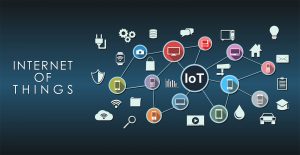Almost every household in America has access to the Internet through Broadband which is readily available and affordable. Today, most devices you purchase have Wi-Fi capabilities or sensors built in. Smart technology is available for televisions, microwaves, coffee pots, and a variety of other items. This massively available connectivity has created the perfect environment for IoT.

The Internet of Things has become the new water cooler topic. This idea has the potential to completely change how we work and live in the world around us. This concept may seem hard to understand because of the technology involved with it, but this post will help you understand the Internet of things and what it means for you.
What is IoT?
This term covers everything and anything that can connect to the web. However, many people define the term as items that talk to each other. These items included such things as sensors,

Besides household items, this term can also refer to the components that communicate to operate large machines such as an airplane or an oil rig drill. Gartner (an analyst firm) predicts that by the year 2020 over 26 billion devices will be connected. Some experts even suggest that number to be over 100 billion.
This large network of things includes the communication relationship between things and things, people and things, and people and people.
This system of connected devices allows us to be able to gather information, analyze this information, and then decide on an action to solve a problem or help complete a given task. It is also possible to learn from this process of data exchange.
This concept also allows devices on private internet connections to communicate across a variety of network types and makes a more connected universe. Hopefully, this explanation has provided an overview of IoT, but some may still be wondering how it all started.
History
Our society tends to use the term Internet of Things a lot, but few seem to know the origin of the phrase. A variety of people and projects helped it progress to the trending topic of today.
The beginning of the concept started as early as 1832 when Baron Schilling from Russia invented the electromagnetic telegraph. In 1833, Carl Friedrich Gauss and Wilhelm Weber from Germany advanced this invention with a unique code to communicate over long distances.
Samuel Morse continued this trend of communicating over distances by sending the first morse code telegraph in 1844. The message was sent from Washington, DC to Baltimore, Maryland.
Over a hundred years later in 1950, Alan Turing suggested giving machines the best sense organs possible and then teach the tools to understand and speak English. He said the process of educating a child to speak and understand could be applied to a machine. This idea made people view devices in a different light.
In 1964, Marshall McLuhan expanded this idea by suggesting electronic media could create an information system. From these ideas, Arpanet was created in 1969. 1974 saw the beginnings of TCP/IP, and then in 1984, the Domain Name System was introduced.
By 1989, Berners-Lee proposed the World Wide Web and fashioned the first web page in 1991. John Romkey connected the first IoT device in 1990. It was a toaster that could be turned on and off over the Internet using a TCP/IP networking device.
The Trojan Room Coffee Pot was created in 1993. The coffee pot levels were monitored by a picture that was updated three times every minute on the building’s server. As technology progressed, the images were placed online.
Amazon and Echobay made the internet commercial in 1995. Sensors became the next wave of infotech with Paul Saffo’s article in 1997. 1998 saw the incorporation of Google and the development of InTouch by Scott Brave, Professor Ishii, and Andrew Dahley at MIT.
The term was also coined in 1998 by Kevin Ashton. In 1999, the Electronic Product Code was developed to replace the UPC bar code system.
The first meme was created in 2000 by LG. In 2002, the Ambient Orb was created by David Rose to monitor the Dow Jones, people’s portfolios, weather, and other data. During 2003-2004, the IoT term appears in mainstream publications and books.
The International Telecommunications Union published the first report on the topic in 2005. Also in 2005, the Nabaztag rabbit was released. It was able to inform the user of news headlines, stock market information, RSS-feeds and other things. The rabbits were even able to connect to each other.
IoT was finally recognized by the EU with the first European Conference. During 2008, companies started the IPSO Alliance to create a common language for the network of smart objects. This alliance helped to cement the Internet of Things. It currently has over 50 major companies as members.
The concept was fully developed during 2008 and 2009 when more objects connected to the internet than people. From this point on, a wide variety of platforms were developed creating the massive network of objects we see today.
Now that we have this extensive network, some wonder do we need it.
Why Do We Need It?
Many experts argue that just because we can connect an object to the internet doesn’t mean we should. The counter argument is that each of the devices connected must collect data for a particular reason that could be helpful to a potential buyer and may impact the economy.
Sensors on production lines can help intensify efficiency and reduce waste which will decrease the cost of the items being produced. Studies have shown that over 35% of American manufacturers have taken advantage of smart sensors which can provide data on amount and condition of the materials being used.
The Internet of Things can save a manufacturer time, money, and emissions in the process of constructing products we use every day. These savings are then passed to the customer. This concept should make businesses, governments, and other public personnel analyze how goods are produced and delivered.
The interactions with devices can allow the potential for change to happen because of the quality and scope of the data being received from the network of things. It is up to the people to make sure this information does not stop at the computer screen.
We need this concept to make our world a better, safer, and more economical place to live. Every day each one of us interacts with examples of the Internet of Things world involving our habits, homes, cities, industries, and the environment.
Examples
This system of things affects our world around us without us even knowing. It has already changed our habits, our homes, the environment, industries, cities, and other areas with a few simple devices.
Some examples of this concept within our habits include:
• Checking on our children– A Mimo monitor gives the parents of tiny babies vital information such as temperature, breathing, position, and activity. This information is sent to a smartphone to 
• Observing an elderly person– Many devices are available that can be placed around the home to track disruptions in the daily routine of an elderly person to prevent injury and give piece of mind.
• Reminders to take medications– GlowCaps replace the lid of prescription bottles and will send reminders via a microchip.
• Track levels of activity– Smartphones have a broad range of sensors such as Gyro, Proximity, GPS and a variety of ways to connect such as WiFi and Bluetooth. These sensors allow you to monitor your daily activity with a device that will fit in your pocket.
These examples are just a few associated with our habits. This network also affects our homes by:
• Efficiently heating our homes– Monthly energy usage can be reduced by at least 30% by using a smart thermostat that monitors weather, activity in the home, etc.
• Watering your plants– When you are out of town, systems like Harvest Geek will feed plants according to their growing needs and conditions.
• Turn off a device– Smart outlets allow you to turn off and on any device that is plugged in it. When you leave in the morning and forget the hair curler, you can use an internet connected device to turn it off.
• Finding lost items– If you lose your keys a lot, use Cobra Tag or Bluetooth technology to keep track of them.
The Internet of Things concept also helps the efficiency of our cities. This efficiency will save money and time which can contribute to reducing the need for increased taxes and decrease the need for more laws. Some examples of this efficiency are:
• Electricity– A SenseNET system installed can help measure the amount of current on a line and the consumption levels. The system sends the data to an application which analyzes the information. This system will also provide information about tampering, malfunctions, and a variety of other issues.
• Street lights– Echelon has created a smart lighting system that allows a town to provide the exact amount of light needed for the time of day or weather conditions. This system has helped cities across the nation to save up to 30% in street light energy.
• Trash cleanup– Smart Belly trash provides real-time information about collections which will alert city services that a bin needs to be emptied. With this information, the bin is only emptied when it is needed and reduces the number of pick-ups when the can does not need to be emptied.
A vast amount of other devices is available to save communities money and time. As discussed earlier, this communication network also helps our industries. It can save time, money, and lifes with the available technology.
• Maintenance and repairs– A lot of equipment comes with sensors installed that can monitor if items have exceeded thresholds or usage limits. This information is sent in a report to the owners and can be used to prevent malfunctions or schedule maintenance before a failure happens.
• Structure Safety– A smart technology will use sensors in the foundation of a building to monitor the quality and integrity of the structure. These sensors can be used during or after construction.
• Fire safety– Enguage has a system that will tell the person in charge when an extinguisher is blocked, gone, or needs maintenance.
These safety devices can also be applied to our homes, schools, and other areas. The final area we will discuss here is the environment. Whether we believe in global warming or not, the communication network between devices has significantly improved our monitoring of the environment.
• Wildlife protection– Maasai herders’ cattle have a collar system to help keep them safe. This same technology is used to keep Southern Kenya’s last 2000 lions safe by sending information about location to researchers.
• Advanced warnings– The University of Loughborough has an ALARMS system that feels waves created by soil movement. The system sends out a signal based on these waves to warn local communities before an event happens.
• Flood treatment– A Floating Sensor Network project uses a drifter to help monitor contaminants, flood water, and conditions of waterways when a flood happens.
The above lists are just a few of the examples of how the IoT can be used to benefit our world. The communication network can provide opportunities and connections that we cannot fully comprehend.
When a company installs a communication network that increases efficiency by just 1%, the results can be astounding. An airline can save over $30 billion in jet fuel. Optimized treatment plans can save the healthcare industry over $63 billion.
As these examples show, we can save with an increase in efficiency, but we need to create a reliable Internet of Things.
Creating a Reliable Network
To create a trusted network, we must have compatible standards which mean all objects connected must be able to talk to each other. They must also be able to transfer information and share observations.
If all of the things are using different standards, this communication may not happen correctly. A huge list details the number of different rules that apply to different devices. This list needs to be condensed into only one standard.
Microsoft has begun to solve this issue with the invention of the IoTCentral which could be the central platform to simplify the networks into one standard. Other groups are working to create an open standard allowing interoperability among different products.
These groups may not be able to agree on only one standard, so we will have to wait and see how it does work out.
As we can all agree security will be a big topic for the Internet of Things. With many companies developing these devices we would suspect that more managed services and other support will start to develop around the IoT world.
Until then, conversations and developments will continue to create a larger network of internet things. For now, we can only take advance of the available technology, enjoy it, and educate ourselves about any updates in the IoT world.
Besides my love for computers, I am a motorcycle fanatic. I have a background in Office 365 support and windows server.
